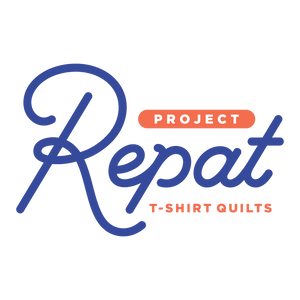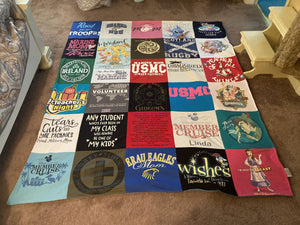What Is the Best Backing for a T-Shirt Quilt?
Aug 29, 2022
A t-shirt quilt is one of the best ways to preserve your apparel from school or travels. Not only does it provide a memento of your past, but it reduces the amount of waste going into our landfills. If you’re creating one with your t-shirt collection, you’ve probably discovered how many options there are for the types of quilt backing.
Having a hard time choosing the best backing for t-shirt quilt? In this article, our experts at Project Repat share everything you need to know about what to use as backing for a t-shirt quilt. Keep reading to find out!
What Is the Backing for a T-Shirt Quilt?
Before we discuss what backing is, you’ll want to learn the basics of t-shirt quilts. To summarize, there are three main components to a quilt: the quilt top, the batting, and the backing. These are connected by the stitching and the quilting, which go around and over all three layers.
The backing is the material that goes on the bottom of the quilt. It’s the side that makes the most skin contact when you use the quilt as a blanket. So, for maximum comfort and quality, it’s important to have the best backing for t-shirt quilts. This is definitely not an aspect of making a t-shirt quilt that you want to overlook - whether you’re doing it yourself or having one commissioned for you!
What To Consider When Deciding What Kind of Backing for a T-Shirt Quilt
There are three factors you’ll want to keep in mind when choosing what kind of backing for a t-shirt quilt: the material itself, backing colors, and the overall quality of your backing. Allow us to break all of them down for you.
Type of Material
Like your t-shirts, quilt backing is available in a variety of materials. There’s cotton, polyester, flannel, minky fabric, polar fleece, and even denim. Whichever you choose, you’ll want something that’s high-quality to withstand daily use and provide breathability for added comfort. Of course, costs will get higher with premium materials.
Printed or Solid Colors
This is another consideration for what to use as backing for a t-shirt quilt since showing or hiding the quilting will depend on these two choices. If you want to show off the quilting pattern, then a solid-color backing is the best option. Those with enough experience can even turn the quilting pattern into an exquisite work of art. However, if you’re still a beginner, then we recommend a printed backing to better hide any mistakes you make.
Quality of the Material
It goes without saying, but the quality of material you’ll use will affect the quality of the project, its longevity, and its comfort. That’s why it’s an important consideration for what to use as backing for a t-shirt quilt. One of the cheapest materials is 100% polyester, but it’s very uncomfortable, not as breathable, and may be prone to static build-up. Then there’s premium cotton, which tends to be more durable and comfortable than the others.
So, What Is the Best Backing for T-Shirt Quilts?
Ready to address the main question at hand today - what is the best backing for a t-shirt quilt? At Project Repat, we believe that fleece is the best backing for a t-shirt quilt. Aside from the advantages, we shared above, this material has qualities that make it an excellent pick when choosing what kind of backing for a t-shirt quilt. These include, but are not limited to:
Other Elements of Your T-Shirt Quilt To Consider
There’s more to this kind of project than just considering what is the best backing for a t-shirt quilt.
- Materials and Equipment for Quilting. First, you want to make sure that you have enough t-shirts in the first place, as this will determine how much quilt backing you’ll need. There isn’t a set number; it just depends on how big you want it to be. In general, you’ll need to have around 15 – 40 t-shirts for a blanket. Check out our in-depth article to learn more about how many t-shirts for a quilt are necessary. If you’re planning to go the full DIY route, you’ll also need to have the equipment for quilting: a sewing machine, thread, needles, a rotary cutter, a cutting mat, and bobbins, just to name a few.
- Technique. If you’re a beginner to quilting, you’re probably already familiar with a running stitch. It’s the simplest technique there is. However, there are many other kinds that you’ll want to learn, especially when making a t-shirt quilt. You’ll want a stitch that helps avoid bunching or stretching while providing a neat and simple design.
- Costs. Another important consideration for your t-shirt quilt is the expenses. While you’ll be saving on fabric due to the shirts you’re providing, you’ll still need to buy the quilt backing, batting, and other tools and materials needed to finish the project. Make a budget and stick to it to avoid making this thrifting project into a major expense. Here’s a more comprehensive breakdown of how much a t-shirt quilt costs.
Want To Get the Best T-Shirt Quilt Possible?
Considering all the things you need to think about, gather, and learn before making a t-shirt quilt, we wouldn’t be surprised if you’re thinking twice about DIY-ing the entire project. It takes a lot of effort and resources on your part, and you might not even get the results you want. It might be better to work with a company that specializes in making these items. And if you’re wondering where to get t-shirt quilts made, you’re in luck - we know just the place!
That’s where Project Repat comes in. As the best t-shirt blanket company online, you can rest easy knowing that your t-shirt quilt is in good hands. Check out our website for our offerings.
Project Repat is one of the most established and popular t-shirt quilting companies in the US, having served more than a million customers in just a few years. We’re the first to specialize in t-shirt quilts, and our longevity in the industry gives us all the experience needed to deliver outstanding quilts to our customers. With 98% of our reviews being 4 or 5 stars, you can be confident that you’re working with experts. We work hard to give people exactly what they want.
One of the best qualities of our company is our transparency. Many similar companies boast of having American-made quilts, but hide from customers that their blankets are made with prison labor where workers are paid cents on the hour. That’s not us.
We also have an intricate system for tracking shirts to ensure that nothing is lost or damaged. We offer upgrades to make the quilt extra special, like embroidery, photos, and custom messaging. Plus, thanks to our systematic processes, it’s easy and convenient to pay for shipping and send shirts to our facility.
Final Thoughts on the Best Backing for T-shirt Quilt
The backing is an essential part of a t-shirt quilt, as it’s what holds everything together to ensure a sturdy yet comfortable final product. So, when you’re asking questions like “what is the best backing for a t-shirt quilt?” make sure that you consider the type of material, the quality, and the colors before making the purchase.
All your thinking, budgeting, and additional effort for the project can be done away with if you let the t-shirt quilting experts at Project Repat handle it instead. We’ll use high-quality fleece as the backing and deliver an outstanding product with all of your memories sewn together in a patchwork of colors. For t-shirt quilts by the #1 custom t-shirt quilt maker, look no further than Project Repat!


